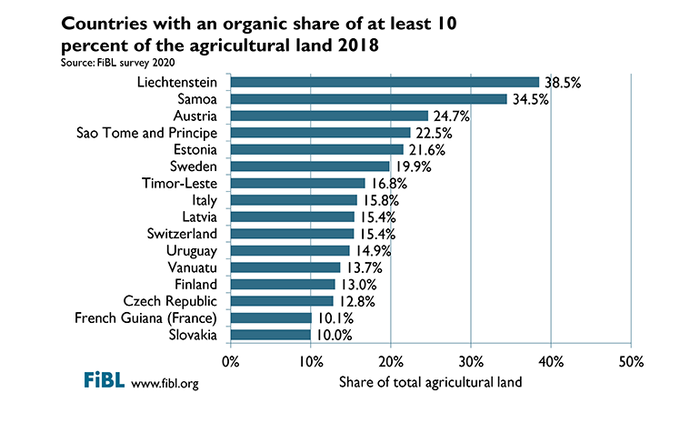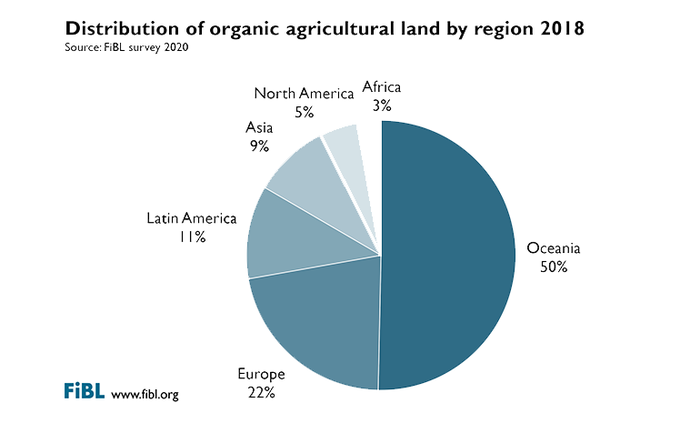Organic acreage and sales continue to grow worldwideOrganic acreage and sales continue to grow worldwide
In the United States and worldwide, organic farmland acreage increased in 2018.
March 5, 2020

Based on data collected from 186 countries, 2018 was another record year for organic agriculture. Organic farmland increased worldwide in 2018 by 2.0 million hectares (4.9 million acres), according to the 21st annual survey, The World of Organic Agriculture, conducted by the Swiss-based Research Institute of Organic Agriculture (FiBL) in partnership with IFOAM Organics International and released in February.

While this represents a modest increase of 2.9%, growth in global acreage has been steady for a number of years. Globally, 1.5% of all farmland is estimated to be organic. However, according to FiBL’s 2020 report, many countries have far higher shares of organic—in 16 countries, 10% or more of all agricultural land is reported to be organic.
Globally, a total of 71.5 million hectares (177 million acres) were organically managed in 2018. Australia recorded the largest organic agricultural area (35.7 million hectares, or 88.2 million acres), followed by Argentina (3.6 million hectares or 8.9 acres) and China (3.1 million hectares or 7.7 million acres). North America, including Canada, Mexico and the U.S., reported 3.3 million hectares or 8.2 million acres of organic agricultural land in 2018.

Because of Australia, FiBL reports, half of all global organic agricultural land is in Oceania. Europe has the second largest area, followed by Latin America. Also, in 2018, 2.8 million organic producers were reported worldwide, with India continuing to be the country with the highest number of producers (1.15 million).
Market research firm Ecovia Intelligence, working with FiBL, estimates that the global market for organic food was more than $100 billion. The U.S. leads the market with sales of $44 billion in 2018, followed by Germany ($11.8 billion) and France ($9.9 billion).
According to the World of Organic Agriculture study, a number of major markets continued to post double-digit growth in 2018, and the organic market in France grew by more than 15%. Danish and Swiss consumers spent the most on organic food in 2018 (312 euros or $339 per capita). Also, Denmark reported the highest market share, with organic sales capturing 11.5% of the country’s total food market.
In related news, market research firm Mercaris reports that U.S. farmers harvested nearly 3.3 million acres of certified organic field crops in 2019, beating previous estimates for every region of the country. Helping to offset a rainy growing season, the harvest was driven by 14% more organic field crop operations, according to the U.S. Department of Agriculture:
By acres harvested, organic hay and alfalfa was up 8% in 2019, with 11% more certified organic farms.
13% more certified organic operations harvested corn in 2019, offsetting a decline in the number of acres harvested per operation.
The U.S. certified organic soybean harvest increased 11% in 2019.
Acres of harvested organic wheat grew 16% year over year as a result of expansion in the High Plains region.
“Despite what can be fairly described as the most difficult growing season in more than a decade, 2019 was a remarkable year for organic production,” Ryan Koory, director of economics at Mercaris, said in the USDA press release. “The addition of new organic growers suggests that 2020 could see organic production reach new record highs."
Have some big ideas or thoughts to share related to the natural products industry? We’d love to hear and publish your opinions in the newhope.com IdeaXchange. Check out our submission guidelines.
About the Author
You May Also Like





